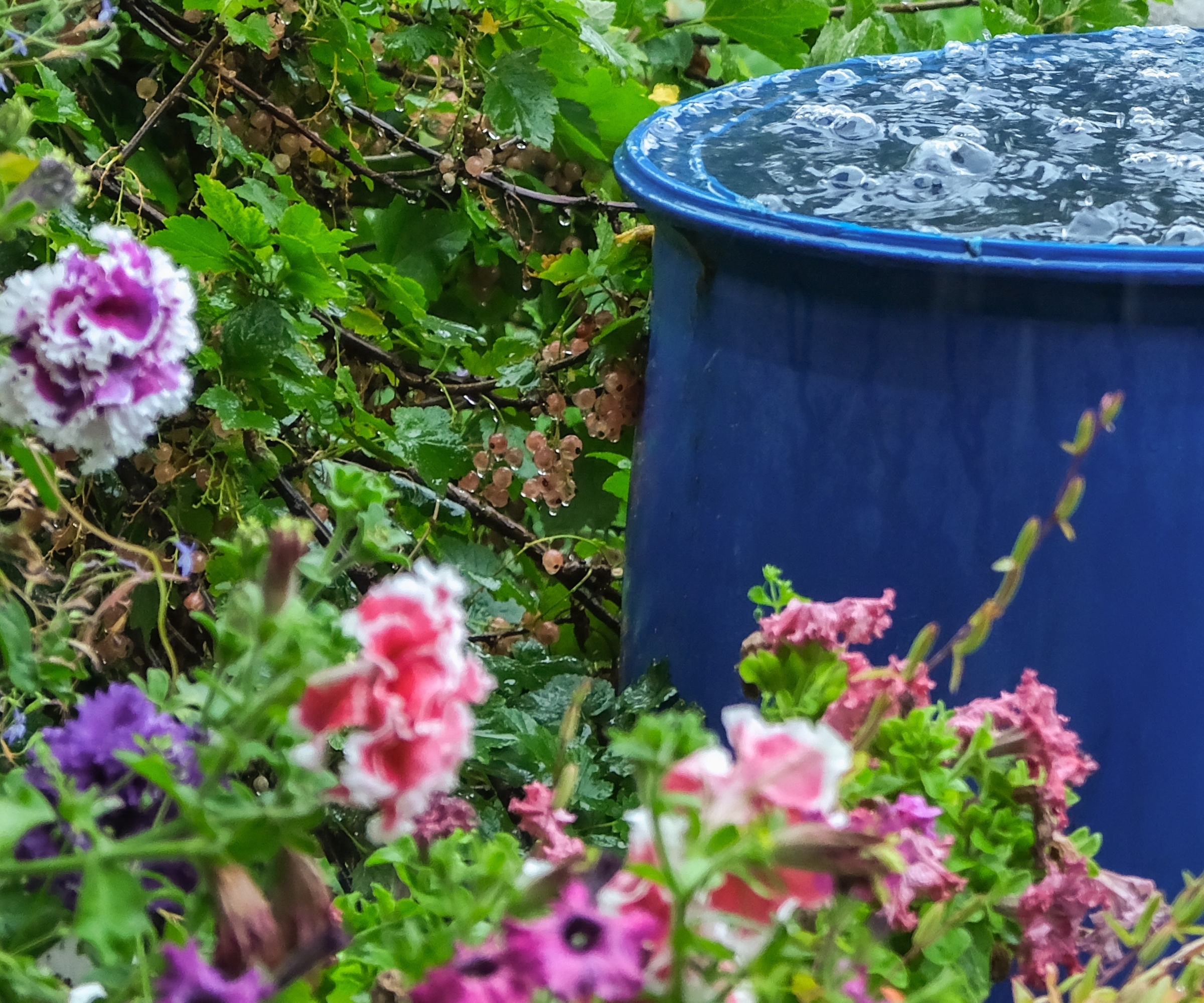How to protect plants from heavy rain – 5 pro tips, plus expert advice on what to do after a downpour
Discover the best ways to protect borders and pots when your yard experiences extremes of weather


Knowing how to protect plants from heavy rain is an increasing concern for gardeners as torrential downpours become more common.
The changing climate is turning gardening from a hobby with set seasonal expectations into something more uncertain, meaning we are having to change the way we grow plants, from vegetables to trees and everything in between.
While we can't change the climate, we can protect our plants and take proactive measures to keep them safe, whatever the elements throw at them.

We can't regulate the rainfall, but we can protect our plants and put the water to good use
5 ways of preventing rain damage to your plants
Prolonged periods of heat and drought followed by unusually heavy rain are happening all over the world through the year with devastating consequences.
Very dry soil can’t cope with sudden downpours and as a result is either washed away, if thin and parched, or becomes a non-porous surface that rain cascades off, causing flooding elsewhere.
These two extremes have disastrous consequences for our plants, so here are our tips for keeping them safe, whether they are in containers or borders in your yard.
1. Improve your soil

Adding organic material and grit to clay soil opens it up and can help prevent flooding
Different soil types behave differently in heavy rain and soil health is important not just for your plants, but for the overall maintenance of your backyard.
Design expertise in your inbox – from inspiring decorating ideas and beautiful celebrity homes to practical gardening advice and shopping round-ups.
Heavy clay will either become waterlogged or, if it has baked solid after a long dry spell, will fail to absorb heavy rain, creating run-off and flooding or pooling elsewhere in the garden.
Thin dry soils can be washed away and lose a lot of their nutrients in torrential downpours.
You can help your plants, and garden as a whole, by making sure your soil is in good health by digging in lots of well-rotted compost and manure (known as organic matter). This helps to open up clay soils, especially if you incorporate grit as well, making it more absorbent and less prone to waterlogging and compaction.
If you have space you could consider planting one of the best trees for clay soil. It will help take up water through its roots, which will also open the soil, creating less run-off.
Digging generous amounts of compost or manure into thin, stony soil also gives it added weight and makes it more able to hold on to water, so it is less likely to wash away in a downpour.
You could also edge your lawn using the Victorian 'moat and mound' technique, when you dig around the borders creating a dry moat and mound the excavated soil on the bed. This makes soil harder to disperse and gives plants extra height - it also looks sharp and attractive.
Many Mediterranean plants thrive in poor soil, so consider planting a variety as they will provide ground cover and their roots will help keep soil knitted together.
2. Improve garden drainage

Gravel paths allow water to escape and can help reduce the risk of flooding - they also look attractive
The simplest and easiest way of improving garden drainage after heavy rain is to aerate the soil using a border fork, such as this top pick from Amazon, aerating machine or shoes with spiked soles to aerate any areas of compacted soil. This is especially effective on waterlogged lawns.
Drive the spikes into the soil, wriggle them about and then do the same all over the area prone to waterlogging.
Gravel paths built over a porous membrane allow water to sink in rather than run off also helps reduce the flooding risk, as does keeping your front yard as a garden instead of turning it into a parking lot.
You could also consider digging a French drain, which is an easy and attractive method of getting rid of excess water from areas of the yard that are prone to flooding or waterlogging.
3. Raise your plants above sodden soil

Use raised beds to lift plant roots so they are less likely to rot after heavy rain
One way of keeping plants safe from waterlogging is to grow them in raised beds or planters.
Raised beds filled with top soil, well rotted organic matter and grit are a good alternative to growing on heavy soils as they drain better and plant roots are lifted above the saturated soil.
Another useful trick is to plant wet-averse plants such as echinacea on small mounds of gritty soil, which raises them above the ground and helps keep their ‘feet’ dry and less susceptible to rotting.
4. Grow plants adapted to wet conditions

Garden with plants such as Siberian Iris that will thrive in wet conditions
If your garden is prone to flooding, consider growing plants that thrive in wet soils - or even create a rain garden.
There are many attractive varieties, but more importantly their roots will help to open up the soil and improve drainage, and also take up some of the excess water.
These can include trees such as birches, hornbeam, maple and willow, ornamental grass such as sedge and blue prairie grass, and plants that like watery or boggy conditions. Think about Siberian irises, hardy hibiscus, crinum, marsh marigolds, liriope and trumpet creeper.
Ferns, including cinnamon fern and the appropriately named marsh fern, will also thrive.
5. If you can't beat it, use it

Use rain water to your advantage by harvesting it to water the garden during dry spells
While heavy rainfall can be as damaging as prolonged drought, rainwater harvesting can be turned to the gardener’s advantage.
Make sure you have several water barrels around the garden to collect the rain. This will protect your soil, lawn and plants but also rain water is better food plants than tap water as it contains fewer chemicals and additives.
Action to take after heavy rain

Warmth after heavy rain in summer can cause a proliferation of problems such as Botrytis grey mold on flowers
Cut away and dispose of any plant material that has been damaged by rain and add it to the compost heap as long as it doesn't show signs of disease. (Adding diseased plant material to the pile is a common composting mistake, as the disease spores will thrive in the warmth of the heap and spread around the yard.)
Removing the damaged material quickly stop it from attracting rots and molds such as Botrytis cinerea, a grey mold that attacks greenery when conditions are warm and wet.
Some flower varieties such as delphiniums may produce a second, smaller flush of flowers later in the summer if you have to remove their main flowering stem. With any luck, multi-stemmed plants will still have several intact budding branches that will still perform well.
Sudden downpours can wash soil away from the root area, destabilising plants, so always do a border check after a storm and replace any that has been lost and firm it down well, without damaging the roots.
How to protect plants in containers

Rain will damage summer bedding such as these begonias in a planter
While container gardening never really goes out of fashion, the most vulnerable plants in the garden are those in pots, whether they are vibrant patio pots, hanging baskets, vegetable garden containers or grow bags.
The easiest way of protecting these plants from very heavy rain is to temporarily move them to a sheltered area of the garden, into the greenhouse, garage, shed or porch or against a wall that acts as a rain shadow or under the eaves of the house.
If you are unable to move heavy pots, cover them with a waterproof tarpaulin, such as these best-selling anti-tear waterproof tarps by QNLONG on Amazon. They come with ropes for securing and are versatile for use around the garden.
If you have hanging baskets on walls or fences that get a lot of weather, take them down and store them in the greenhouse while the storm blows through. Stand them on an upturned tub or large pot so the trailing plants aren’t damaged.
After the deluge, remove any plant material that has been badly battered or damaged by the rain so it doesn’t start to rot and provide an entry point for pests and disease.
Make sure the potting soil doesn’t get waterlogged by adding a layer of gravel or crocks to the base of the pot before you add compost and always raise planters using 'feet' like these discreet, non-slip risers on Amazon, so excess water has room to drain away.
How to protect plants in borders

Heavy rain can cause serious damage to unprotected garden plants
In some ways, plants in borders and beds are less at risk than those in pots because there is room for water to escape before roots get waterlogged. However, there are other dangers they have to face and be protected from.
Prolonged very heavy rain can knock plants to the ground, damaging blooms and snapping stems.
Tall varieties such as delphiniums and sunflowers, as well as plants with large flower heads such as 'dinnerplate' types of dahlias and flowering climbers against exposed walls are especially susceptible, so always make sure they have adequate support.
FAQs
How can I protect my lawn from heavy rain?
The easiest way to protect your lawn is to lay a stepping stone path across areas that get heavy footfall. Estimate how many stones you need and then lay them on the grass so you can walk easily on them.
Then cut around each stone using a sharp edging tool and remove the turf to a level slightly deeper than the stone. Add a layer of sand and settle the stone on it. Brush soil and sand around each stone and they will soon bed in and the grass will grow around them, creating an attractive path that stops the grass becoming a mud bath.
Can I dig the soil after heavy rain?
Not immediately. Avoid walking on or digging the soil after very heavy rain because our weight will compact it and damage its structure. Compressed soil is harder to grow in and more likely to cause flooding because rain will simply run off it.
If you feel you need to get onto the soil after a storm, wait a day or two and then lay a wide plank of wood or piece on board over the surface of the soil and tread on that. It will disperse your weight and cause less damage.
You will need to go on pest patrol after heavy rain and remove slugs and snails that are lured out by the warmth and dampness.
An easy way of getting rid of them is to lie a large leaf on the soil close to the plants they attack. The slugs and snails will crawl under it and they can be collected up and moved elsewhere.

Ruth is a Contributing Editor for Homes & Gardens, and formerly Gardening Editor of Amateur Gardening magazine. She is horticulturally trained, with a qualification from the Royal Horticultural Society. Her work for Amateur Gardening, the world's oldest weekly gardening publication, involved matching gardening tasks with each season, covering everything from sowing and planting, to pruning, taking cuttings, dealing with pests and diseases and keeping houseplants healthy. She is an expert in ornamental plants and edible crops, and everything she writes about and photographs is in her own garden, that has been a work in progress since her family moved there in 2012.
